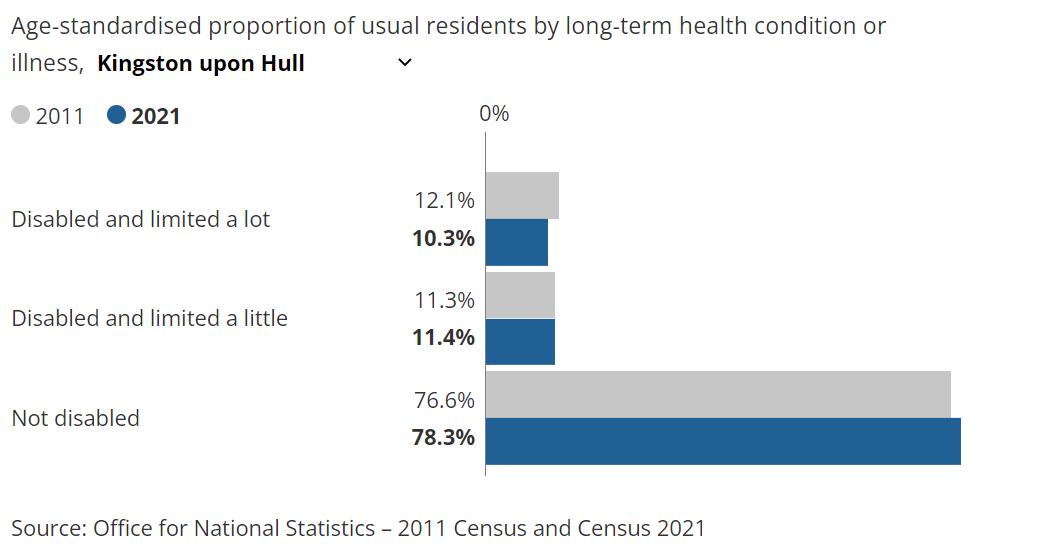The population reached nearly 270,000
Between the last two censuses (held in 2011 and 2021), the population of Kingston upon Hull increased by 4.1%, from just over 256,400 in 2011 to around 267,000 in 2021.
The population here increased at a similar rate to the overall population of Yorkshire and The Humber (3.7%), but by a smaller percentage than the overall population of England (up 6.6% since the 2011 Census).
In 2021, Kingston upon Hull was home to around 26.6 people per football pitch-sized piece of land, compared with 25.6 in 2011. This area was the most densely populated local authority area across Yorkshire and The Humber.
This article generally uses percentages to enable comparisons over time and between areas. The percentage point change is also used to show the difference between the 2011 and 2021 percentages.
Population growth was higher in Kingston upon Hull than across Yorkshire and The Humber
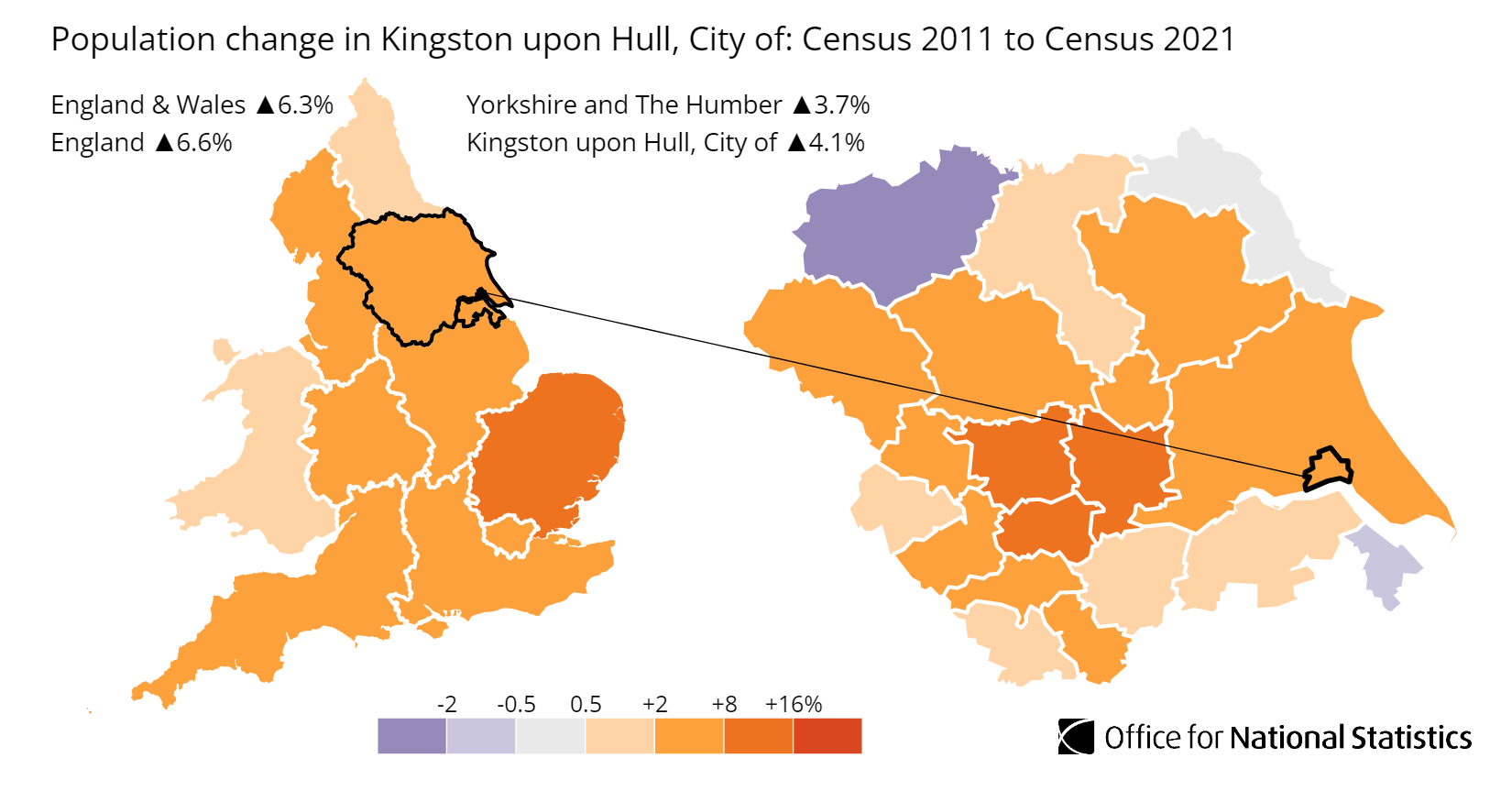
Median age stable in Kingston upon Hull
The latest census data also show that the median age remained 36 years in Kingston upon Hull between the last two censuses.
The median age is the age of the person in the middle of the group, meaning that one half of the group is younger than that person and the other half is older.
This area had the joint lowest median age in Yorkshire and The Humber (alongside Bradford and Leeds) and a lower median age than England (40 years).
The number of people aged 50 to 64 years rose by just under 5,900 (an increase of 13.5%), while the number of residents between 20 and 24 years fell by around 4,600 (19.2% decrease).
The share of residents aged between 50 and 64 years increased by 1.5 percentage points between 2011 and 2021
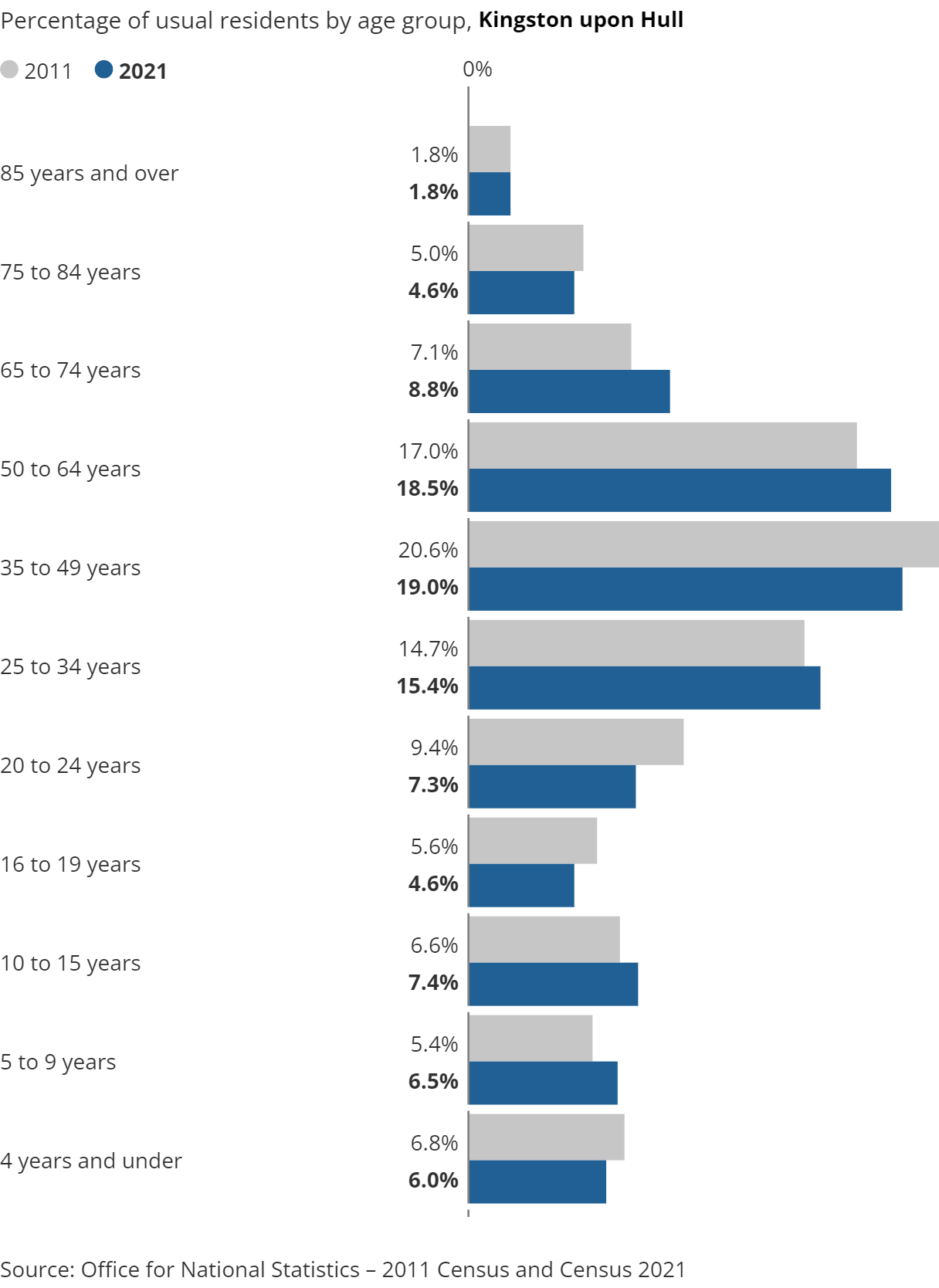 Employment in Kingston upon Hull
Employment in Kingston upon Hull
The percentage of people aged 16 years and over (excluding full-time students) who were employed increased in Kingston upon Hull, while falling across Yorkshire and The Humber.
In Kingston upon Hull, the percentage who were employed rose from 51.1% in 2011 to 53.3% in 2021. During the same period, the regional percentage fell from 54.5% to 53.5%.
The percentage of people aged 16 years and over who were unemployed (excluding full-time students) in Kingston upon Hull fell from 7.4% to 4.1%, while the percentage of people aged 16 years and over who were retired (economically inactive) decreased from 18.9% to 18.0%.
Census 2021 took place during the coronavirus (COVID-19) pandemic, a period of rapid and unparalleled change; the national lockdown, associated guidance and furlough measures will have affected the labour market and our ability to measure it.
The percentage of people aged 16 years and over who were employed (excluding full-time students) in Kingston upon Hull increased by 2.3 percentage points
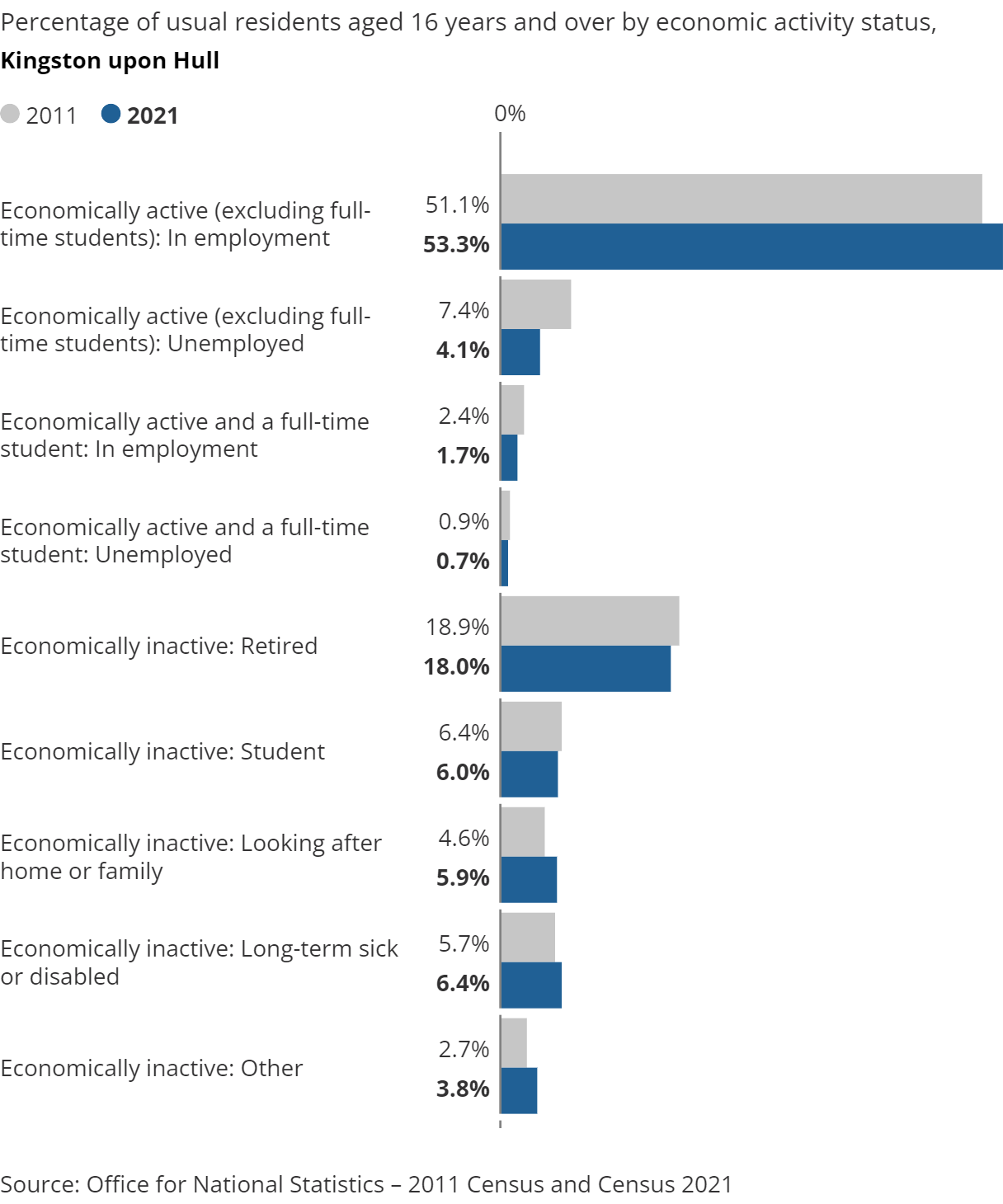 Change in work hours
Change in work hours
Kingston upon Hull saw England’s third-largest percentage-point fall in the share of people aged 16 years and over and in employment who said they usually worked 15 hours or less per week (from 9.0% in 2011 to 8.0% in 2021).
England’s largest decreases in the percentage of people aged 16 years and over and in employment who said they usually worked 15 hours or less per week occurred in Barrow-in-Furness (from 9.9% to 8.5%) followed by Southampton (from 11.6% to 10.5%).
During this period, Kingston upon Hull went from being among the lowest 30% of English local authority areas based on its share of people aged 16 years and over and in employment who said they usually worked 15 hours or less per week to being among the lowest 2%.
Working hours may have been affected by the coronavirus (COVID-19) pandemic.
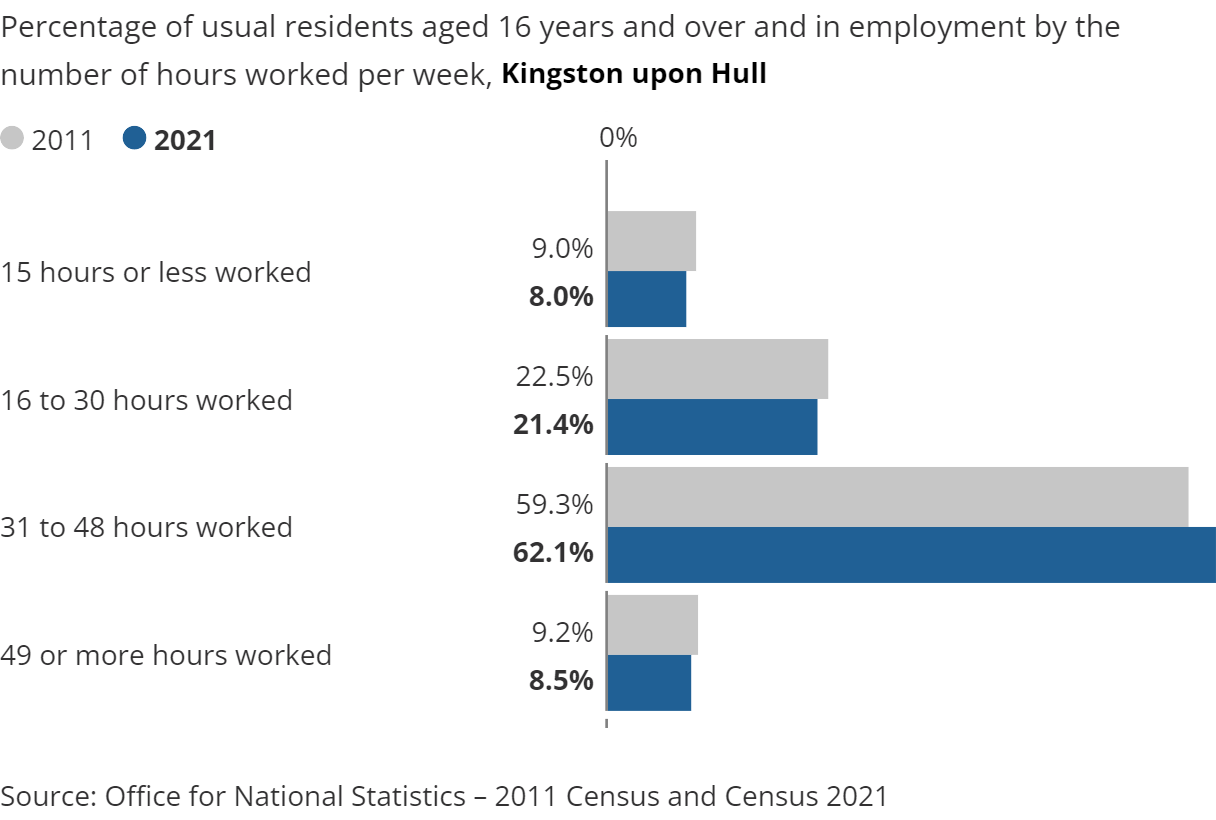
Family in Kingston upon Hull
The percentage of households including a couple but no children increased here, while falling across Yorkshire and The Humber.
In Kingston upon Hull, the percentage of households including a couple without children rose from 16.0% in 2011 to 16.4% in 2021. During the same period, the regional percentage fell from 18.7% to 17.7%.
The percentage of households including a couple with dependent children in Kingston upon Hull increased from 17.0% to 17.4%, while the percentage of households including a couple with only non-dependent children decreased from 5.8% to 5.6%.
The percentage of households including a couple without children in Kingston upon Hull increased by 0.5 percentage points
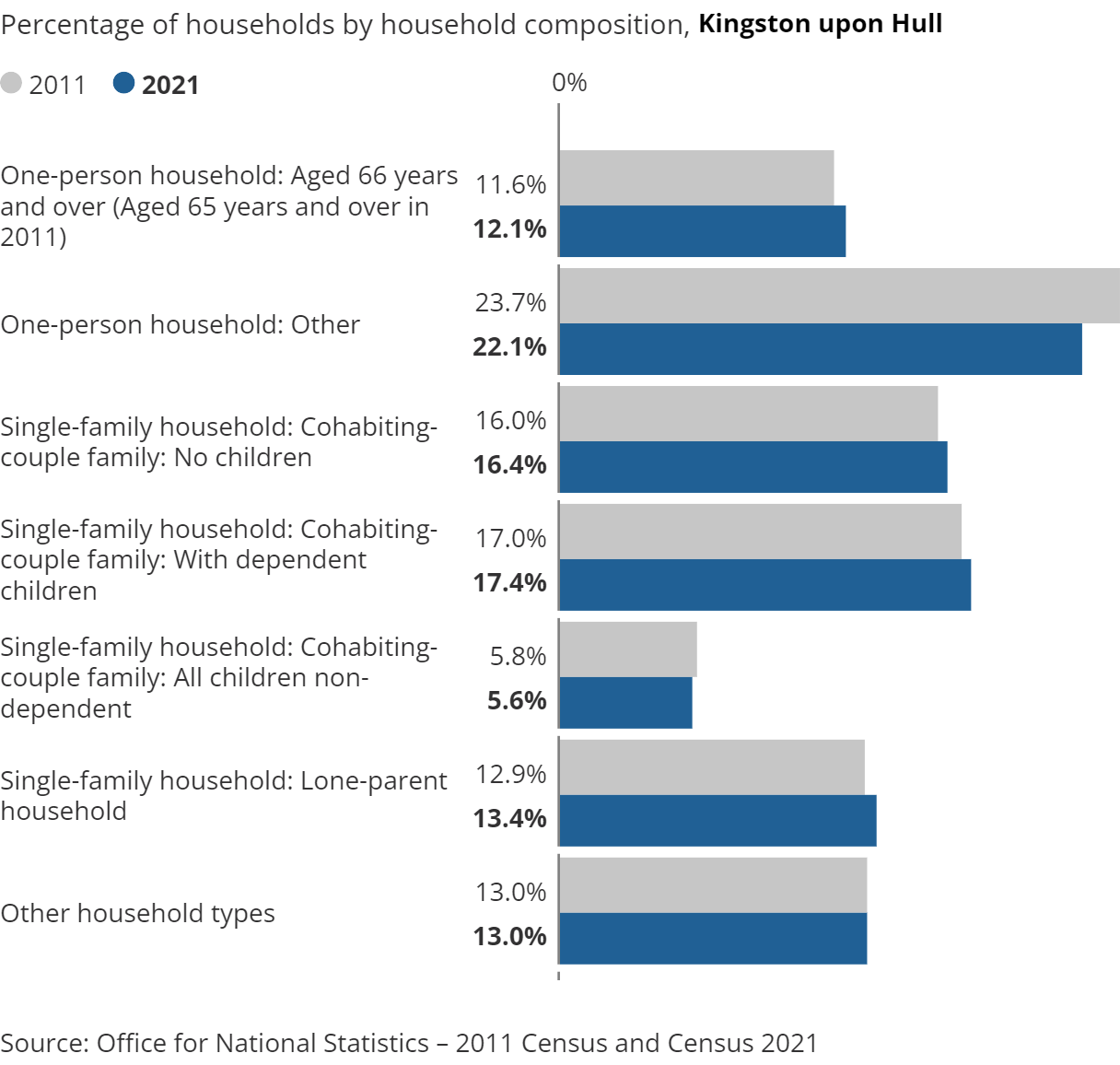
Kingston upon Hull residents’ country of birth
In the latest census, around 229,100 Kingston upon Hull residents said they were born in England. This represented 85.8% of the local population. The figure has decreased from just over 231,000 in 2011, which at the time represented 90.1% of Kingston upon Hull’s population.
Poland was the next most represented, with just under 9,100 Kingston upon Hull residents reporting this country of birth (3.4%). This figure was up from around 4,800 in 2011, which at the time represented 1.9% of the population of Kingston upon Hull.
The number of Kingston upon Hull residents born in Romania rose from around 200 in 2011 (0.1% of the local population) to just over 3,600 in 2021 (1.3%).
In 2021, 85.8% of Kingston upon Hull residents reported their country of birth as England
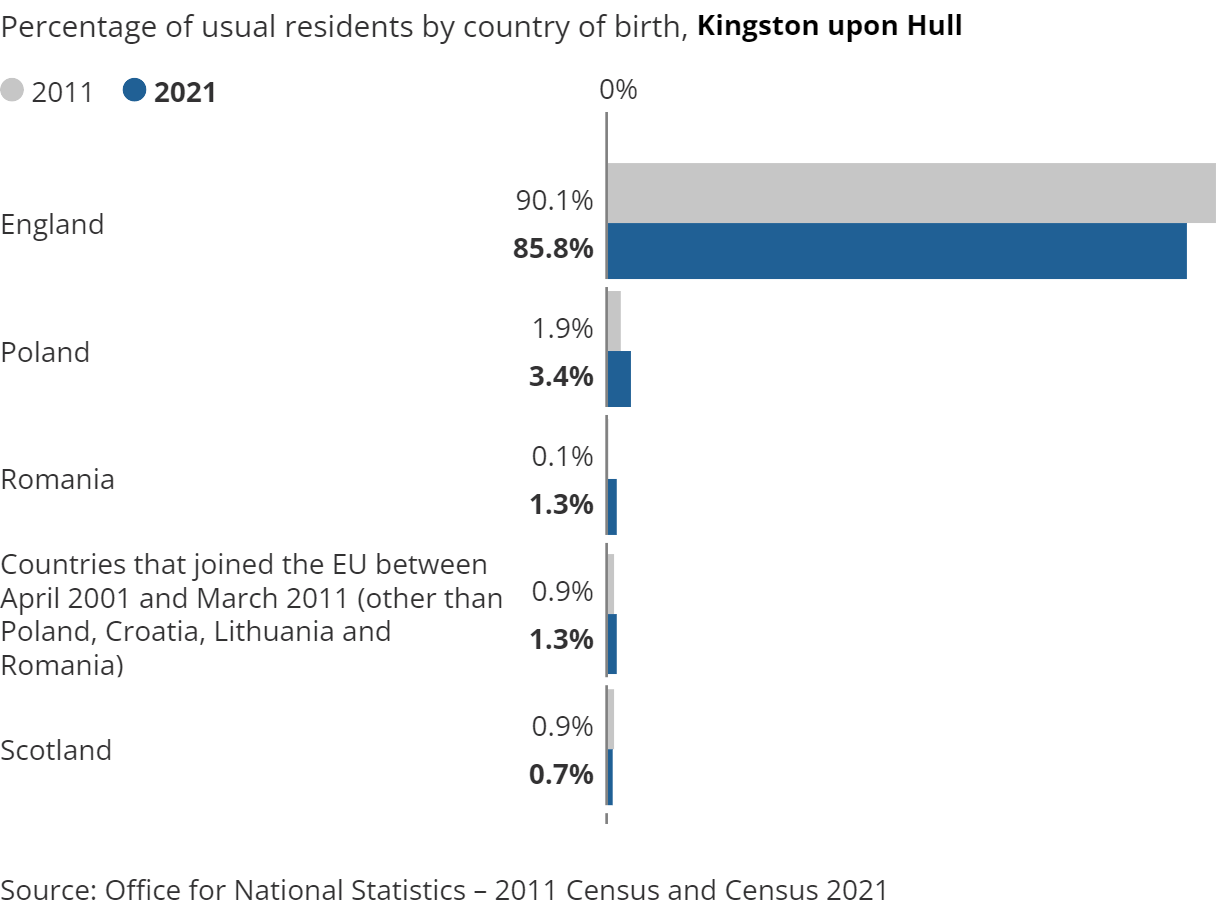
NATIONAL IDENTITY IN KINGSTON UPON HULL
Kingston upon Hull saw Yorkshire and The Humber’s largest percentage-point rise in the proportion of people who did not identify with any national identity associated with the UK (from 6.7% in 2011 to 10.1% in 2021).
Doncaster saw Yorkshire and The Humber’s next largest increase in the percentage of people who did not identify with any national identity associated with the UK (from 4.1% in 2011 to 7.0% in 2021).
Across Yorkshire and The Humber, the percentage of people who did not identify with any national identity associated with the UK increased from 5.1% to 6.7%, while the percentage in nearby East Riding of Yorkshire increased from 2.1% to 2.8%.
In Census 2021, “British” was moved to the top response option and this may have influenced how people described their national identity.
The percentage of people who did not identify with at least one UK national identity in Kingston upon Hull increased by 3.4 percentage points
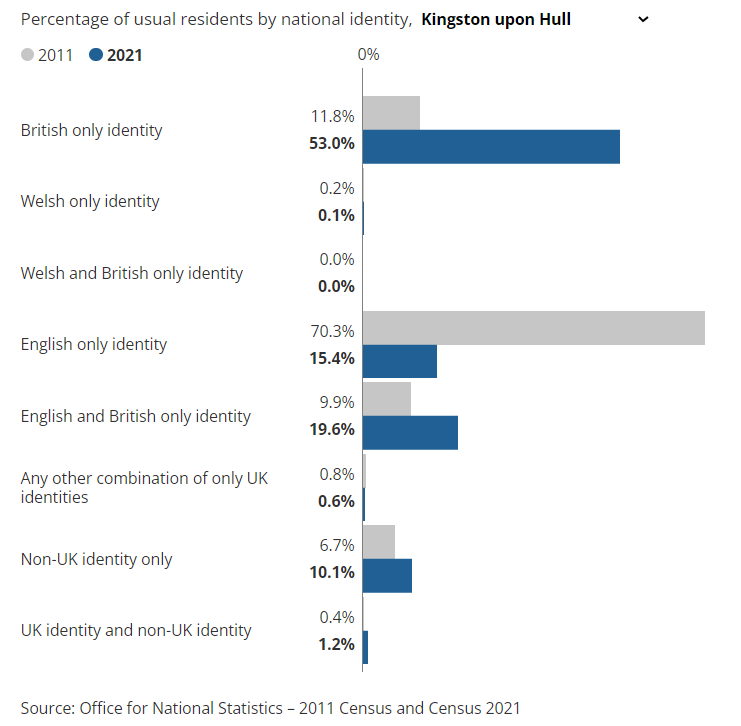
UNPAID CARE IN KINGSTON UPON HULL
In 2021, 3.4% of Kingston upon Hull residents (aged five years and over) reported providing up to 19 hours of unpaid care each week. This figure decreased from 5.5% in 2011. These are age-standardised proportions.
Age-standardised proportions are used throughout this section. They enable comparisons between populations over time and across geographies, as they account for differences in the population size and age structure.
In 2021, just over 1 in 50 people (2.1%) reported providing between 20 and 49 hours of unpaid care each week, compared with 1.6% in 2011. The proportion of Kingston upon Hull residents (aged five years and over) that provided at least 50 hours of weekly unpaid care remained at 3.5%.
This area had the region’s lowest proportion of people (aged five years and over) providing up to 19 hours of weekly unpaid care. North East Lincolnshire had Yorkshire and The Humber’s next lowest proportion of people (aged five years and over) providing up to 19 hours of weekly unpaid care (4.0%), while Hambleton and Craven had the region’s joint highest proportion (5.0%).
Census 2021 was undertaken during the coronavirus (COVID-19) pandemic. This may have influenced how people perceived and managed their provision of unpaid care, and therefore may have affected how people chose to respond.
Caution should be taken when making comparisons between 2011 and 2021 because of changes in question wording and response options.
The percentage of people (aged five years and over) providing up to 19 hours of weekly unpaid care in Kingston upon Hull decreased by 2.1 percentage points

ETHNIC GROUPS IN KINGSTON UPON HULL
In 2021, 1.8% of Kingston upon Hull residents identified their ethnic group within the “Other” category (“Arab” or “Any other ethnic group”), up from 0.8% in 2011. The 1.0 percentage-point change was the largest increase among high-level ethnic groups in this area.
Across Yorkshire and The Humber, the percentage of people from the “Other ethnic groups” (“Arab” or “Any other ethnic group”) increased from 0.8% to 1.4%, while across England the percentage increased from 1.0% to 2.2%.
In 2021, 91.8% of people in Kingston upon Hull identified their ethnic group within the “White” category (compared with 94.1% in 2011), while 2.8% identified their ethnic group within the “Asian, Asian British or Asian Welsh” category (compared with 2.5% the previous decade).
The percentage of people who identified their ethnic group within the “Black, Black British, Black Welsh, Caribbean or African” category increased from 1.2% in 2011 to 1.9% in 2021.
There are many factors that may be contributing to the changing ethnic composition of England and Wales, such as differing patterns of ageing, fertility, mortality, and migration. Changes may also be caused by differences in the way individuals chose to self-identify between censuses.
In 2021, 1.8% of usual residents in Kingston upon Hull identified their ethnic group within the “Other” category (“Arab” or “Any other ethnic group”)
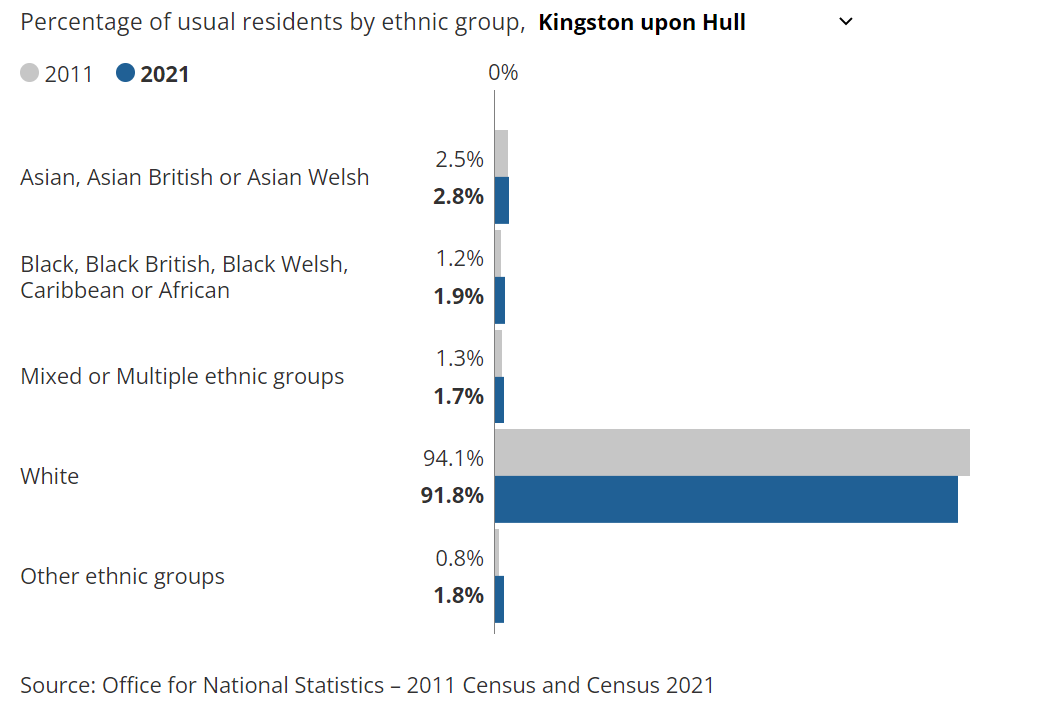
MARRIAGE AND CIVIL PARTNERSHIP IN KINGSTON UPON HULL
Of Kingston upon Hull residents aged 16 years and over, 35.6% said they were married or in a registered civil partnership in 2021, down from 37.8% in 2011.
In 2021, just under one in two people (45.8%) said they had never been married or in a civil partnership, compared with 42.1% in 2011. The percentage of adults in Kingston upon Hull that had divorced or dissolved a civil partnership decreased from 10.3% to 10.1%.
This area had the region’s lowest percentage of people aged 16 years and over who were married (or in a civil partnership). Leeds had Yorkshire and The Humber’s next lowest percentage of people aged 16 years and over who were married (or in a civil partnership) (39.6%), while Hambleton had the region’s highest percentage (54.0%).
These figures include same-sex marriages and opposite-sex civil partnerships in 2021, neither of which were legally recognised in England and Wales in 2011. Same-sex marriages have been legally recognised in England and Wales since 2014 and opposite-sex civil partnerships have been recognised since 2019.
The percentage of adults who were married or in a civil partnership in Kingston upon Hull decreased by 2.1 percentage points
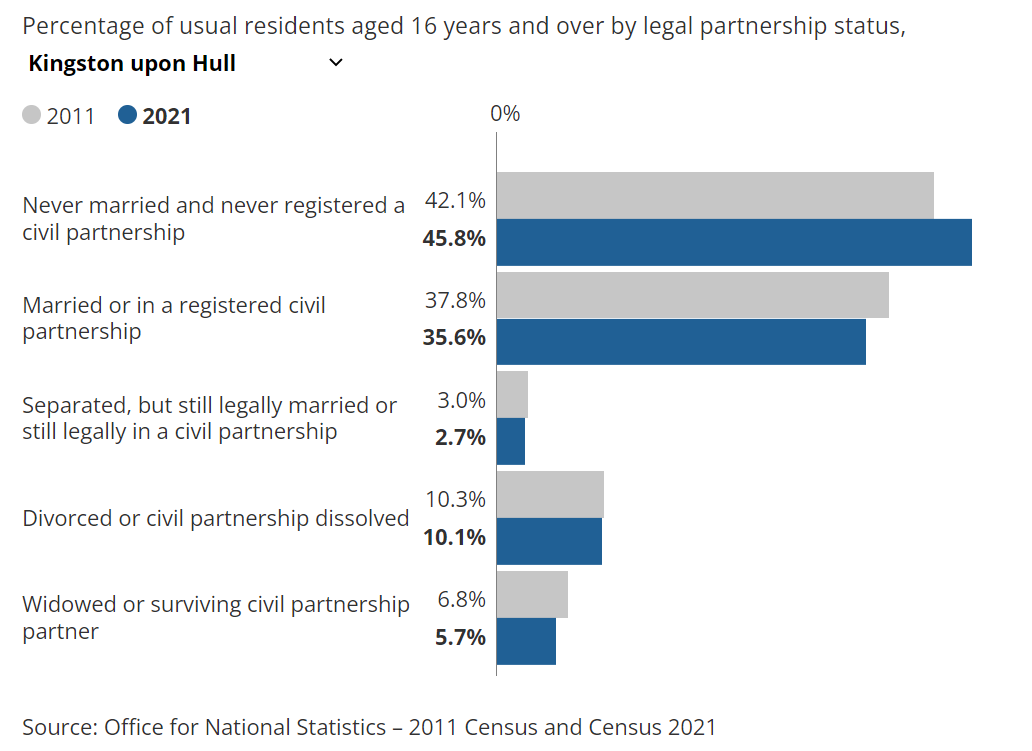
RELIGION IN KINGSTON UPON HULL
In 2021, 49.2% of Kingston upon Hull residents reported having “No religion”, making it the most common response in this local authority area (up from 34.8% in 2011). Because the census question about religious affiliation is voluntary and has varying response rates, caution is needed when comparing figures between different areas or between censuses.
Across Yorkshire and The Humber, the percentage of residents who described themselves as having “No religion” increased from 25.9% to 39.4%, while across England the percentage increased from 24.8% to 36.7%.
In 2021, 39.9% of people in Kingston upon Hull described themselves as Christian (down from 54.9%), while 6.4% did not state their religion (down from 7.2% the decade before).
There are many factors that can cause changes to the religious profile of an area, such as a changing age structure or residents relocating for work or education. Changes may also be caused by differences in the way individuals chose to self-identify between censuses. Religious affiliation is the religion with which someone connects or identifies, rather than their beliefs or religious practice.
In 2021, 49.2% of usual residents in Kingston upon Hull reported having “No religion”

HEALTH IN KINGSTON UPON HULL
In 2021, 40.3% of Kingston upon Hull residents described their health as “very good”, increasing from 39.1% in 2011. Those describing their health as “good” rose from 35.2% to 35.5%. These are age-standardised proportions.
Age-standardised proportions are used throughout this section. They enable comparisons between populations over time and across geographies, as they account for differences in the population size and age structure.
The proportion of Kingston upon Hull residents describing their health as “very bad” was 1.8% (similar to 2011), while those describing their health as “bad” fell from 6.5% to 5.9%.
These data reflect people’s own opinions in describing their overall health on a five point scale, from very good to very bad.
Census 2021 was conducted during the coronavirus (COVID-19) pandemic. This may have influenced how people perceived and rated their health, and therefore may have affected how people chose to respond.
The percentage of people in good health in Kingston upon Hull increased by 0.3 percentage points
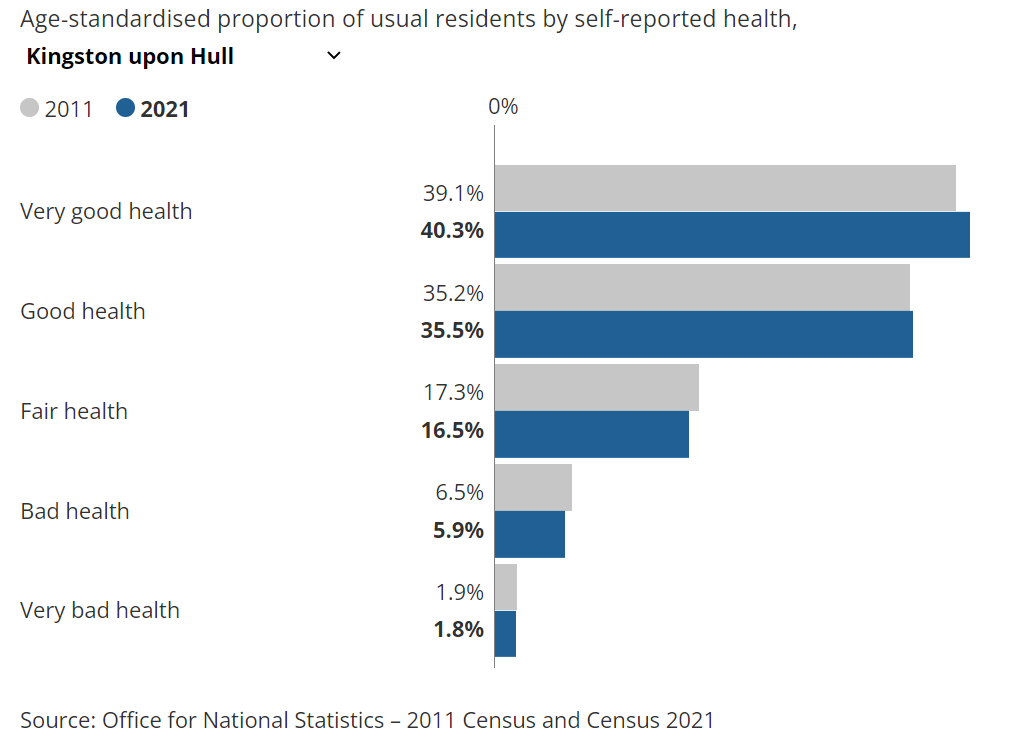
FALL IN HOME OWNERSHIP
Of Kingston upon Hull households, 48.3% owned their home in 2021, down from 49.5% in 2011.
In 2021, just under one in four households (23.9%) rented privately, compared with 20.4% in 2011. The percentage of Kingston upon Hull households that lived in a socially rented property decreased from 28.1% to 27.0%.
This area had the region’s lowest percentage of households that owned their home. Leeds had Yorkshire and The Humber’s next lowest percentage of households that owned their home (57.0%), while Selby and East Riding of Yorkshire had the region’s joint highest percentage (73.1%).
The rate of home ownership in Kingston upon Hull decreased by 1.3 percentage points
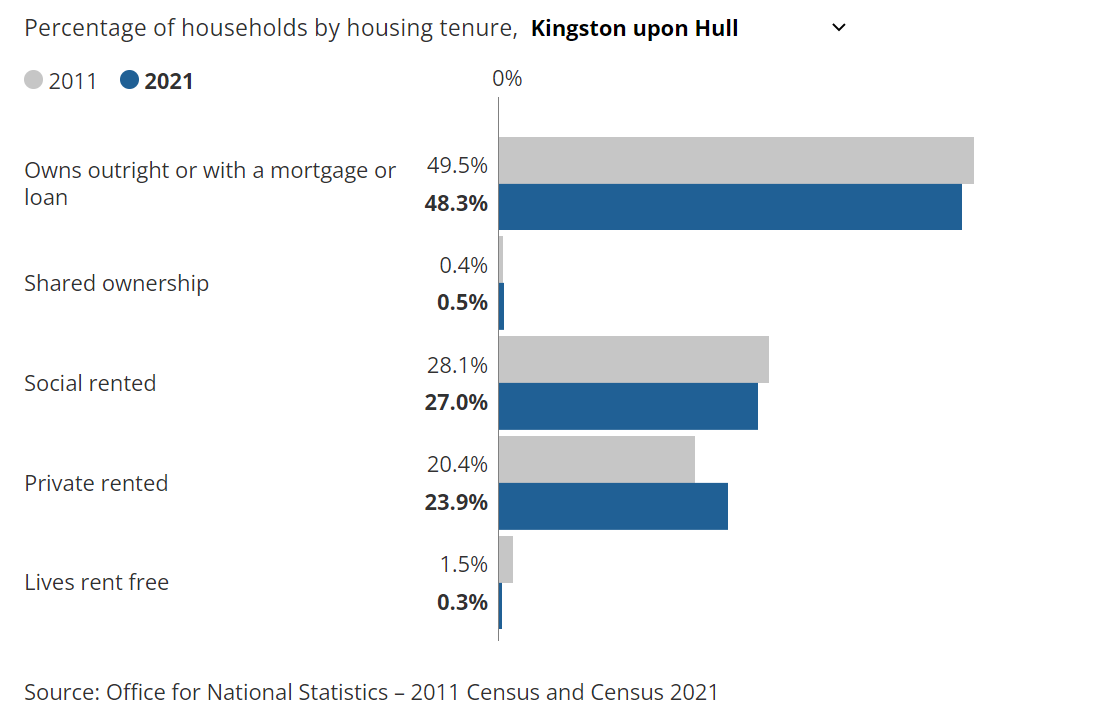
DISABILITY IN KINGSTON UPON HULL
In 2021, 10.3% of Kingston upon Hull residents were identified as being disabled and limited a lot. This figure decreased from 12.1% in 2011. These are age-standardised proportions.
Age-standardised proportions are used throughout this section. They enable comparisons between populations over time and across geographies, as they account for differences in the population size and age structure.
In 2021, just over one in nine people (11.4%) were identified as being disabled and limited a little, compared with 11.3% in 2011. The proportion of Kingston upon Hull residents who were not disabled increased from 76.6% to 78.3%.
This area had the region’s second highest proportion of residents who were identified as being disabled and limited a lot. Across the region, only Barnsley, with 10.6%, had a higher proportion.
Census 2021 was undertaken during the coronavirus (COVID-19) pandemic. This may have influenced how people perceived their health status and activity limitations, and therefore may have affected how people chose to respond.
Caution should be taken when making comparisons between 2011 and 2021 because of changes in question wording and response options.
The percentage of people who were identified as being disabled and limited a lot in Kingston upon Hull decreased by 1.8 percentage points
